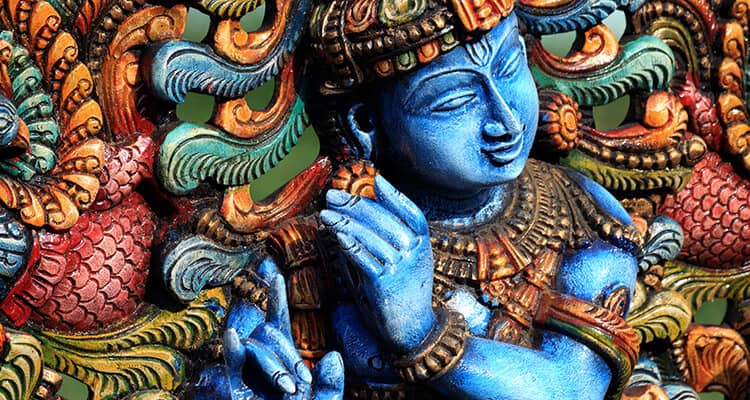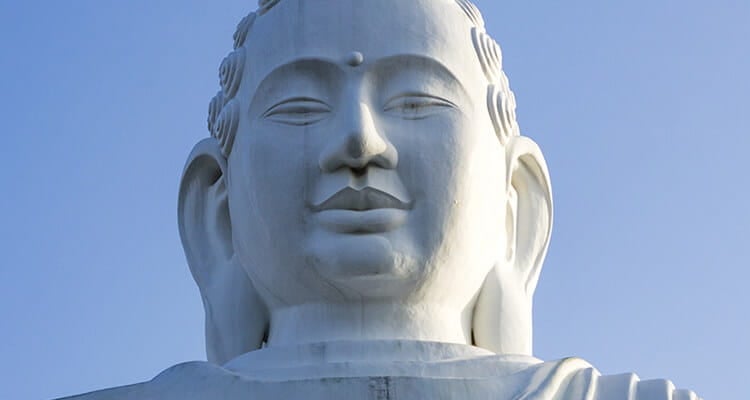- Trending:
- Pope Leo Xiv
- |
- Israel
- |
- Trump
- |
- Social Justice
- |
- Peace
- |
- Love
Patheos Lenses
Side by Side Comparison
The Side by Side Lens allows you to create an easy to read comparison chart for up to three differing religious traditions. Select your traditions from the drop down menus. You can click on the major sections on each chart you build, in order to see more detailed comparisons.
Quick Facts
JUMP TO SECTION
Origins
| Hinduism | Mahayana Buddhism | |
|---|---|---|
| Beginnings | ||
|
Hinduism
Hinduism is a perpetually evolving collection of an astounding array of philosophical, ritual, and devotional traditions. There is no founder, and there is no fixed moment of origin. Hindus often refer to their religion as "sanatana dharma" — the timeless, eternal truth.
| read more »
|
Mahayana Buddhism
The Mahayana emerged between 100 B.C.E. and 100 C.E. in India in the context of debate about proper Buddhist doctrine and practice, about monastic discipline, and particularly about the ongoing presence of the Buddha after his death as well as the nature of enlightenment itself.
| read more »
|
|
| Influences | ||
|
Hinduism
What we call Hinduism has for thousands of years been in a constant process of change, absorbing and reacting to a tremendous array of influences.
| read more »
|
Mahayana Buddhism
Initially, the Mahayana was influenced by other Buddhist schools of thought in India; as it spread in and beyond India, it absorbed and adopted aspects of indigenous religious traditions, such as Taoism, Confucianism, Bon, and various forms of Hinduism.
| read more »
|
|
| Founders | ||
|
Hinduism
Hinduism does not have a founder or date of origin. Rather, it has been traditionally viewed as a timeless tradition that has been and continues to be revealed to humans at the start of each world cycle.
| read more »
|
Mahayana Buddhism
The philosopher/monk Nagarjuna is sometimes said to be the founder of the Mahayana, along with such early figures as Asanga and Vasubandhu, although each of these figures actually founded sub-schools within the early Mahayana; in reality there is no single founder of the tradition.
| read more »
|
|
| Scriptures | ||
|
Hinduism
Hinduism does not rely exclusively on any single scripture, but rather on a vast collection of sacred writings of which the Vedas are the foundation.
| read more »
|
Mahayana Buddhism
The earliest Mahayana texts compose the vast corpus known as the "Prajnaparamita" ("Perfection of Wisdom"), which forms the foundation of many later Mahayana schools. Other important early texts include the "Sadharmapundarika" ("Lotus Sutra") and the "Vimalakirti Nirdesha Sutra."
| read more »
|
|
| Historical Perspectives | ||
|
Hinduism
The context of colonialism has hovered over western representations of Hinduism. Many Indians have objected to western scholarly stereotypes and misrepresentations.
| read more »
|
Mahayana Buddhism
Mahayana thought has been extremely influential in western philosophy and, in recent decades, western religious and ethical practice. Early scholarship on the Mahayana focused primarily on Mahayana thought, but more attention recently has been paid to ritual and devotional practices.
| read more »
|
|
History
| Hinduism | Mahayana Buddhism | |
|---|---|---|
| Early Developments | ||
|
Hinduism
The religious tradition that we call "Hinduism" has constantly changed over its 3,500 year history, absorbing a myriad of cultural influences.
| read more »
|
Mahayana Buddhism
The early Mahayana is marked by, among other things, a profound emphasis on the importance of the book; hundreds of new texts were written, copied, disseminated, and often worshipped. This may have been intended to counter the dominance of stupa veneration in other Buddhist schools.
| read more »
|
|
| Schisms, Sects | ||
|
Hinduism
The Hindu tradition encompasses four major sects—Shaiva, Vaishnava, Shakta, and Smarta—and dozens of minor subsects.
| read more »
|
Mahayana Buddhism
The Mahayana itself is often understood as a schismatic movement. After the initial emergence of the Mahayana, a number of important subschools emerged in India and then in China—among them Madhyamaka, Yogacara, the Pure Land Schools, and Ch'an.
| read more »
|
|
| Missions, Spread, Changes, Regional adaptations | ||
|
Hinduism
Hinduism has historically been a non-missionizing religious tradition. It has, however, spread to many parts of South and Southeast Asia, and to the West, and in the process has adapted to the cultural of these regions.
| read more »
|
Mahayana Buddhism
The Mahayana spread throughout the Indian subcontinent through the missionary activities of monks and the patronage of kings. By the 2nd century C.E. it had made its way to China. It also spread to both east and southeast Asia.
| read more »
|
|
| Exploration, Conquest, Empire (incl. violence, persecution) | ||
|
Hinduism
Hindus have not, generally, engaged in colonial conquest or empire building outside of India, although Hindu kingdoms were established in some parts of South and Southeast Asia.
| read more »
|
Mahayana Buddhism
A variety of kings in both India and east and southeast Asia supported the Mahayana, among them: the Kushanas, Guptas, and Palas in India; the Han and Tang in China; the Srivijaya and Sailendra in Indonesia.
| read more »
|
|
| Modern Age | ||
|
Hinduism
Two major developments in the modern era have posed significant challenges to Hinduism and have led to substantial internal changes: the British colonization of India beginning in the 18th century, and rising tensions between Hindus and Muslims in India.
| read more »
|
Mahayana Buddhism
Mahayana Buddhism has adapted to tremendous change in its 2000-year history, and the tradition has continued to evolve in the modern world. In Asia, Europe, and North America the Mahayana has thrived, often by integrating seeming secular aspects of political and social-welfare activities into its practices.
| read more »
|
|
Beliefs
| Hinduism | Mahayana Buddhism | |
|---|---|---|
| Sacred narratives | ||
|
Hinduism
Unlike other religious traditions, Hinduism has no single, unifying sacred narrative. Rather, there is a vast array of narratives—theological, ethical, ritual, mythical, social—that different Hindus in different contexts hold sacred.
| read more »
|
Mahayana Buddhism
There is no single sacred narrative in Mahayana Buddhism. Accounts of the lives and activities of the buddhas, boddhisattvas, female deities, and significant monks serve as a means of spreading and explaining Mahayana doctrine and practice.
| read more »
|
|
| Ultimate Reality and Divine Beings | ||
|
Hinduism
A major question to ask about Hinduism is whether it is a polytheistic or a monotheistic religion. The short answer is "yes"—it is both.
| read more »
|
Mahayana Buddhism
The bodhisattva is perhaps the defining characteristic of the Mahayana. Bodhisattvas are enlightened beings who remain in the world to assist those beings still suffering in samsara. The Mahayana pantheon is populated by thousands of bodhisattvas, as well as buddhas and goddess-like figures.
| read more »
|
|
| Human Nature and the Purpose of Existence | ||
|
Hinduism
Hinduism is in many ways a profoundly structured religion that presents what sometimes appears to be a highly rigid understanding of human existence. Within that structure, however, human beings are always free.
| read more »
|
Mahayana Buddhism
The Mahayana holds that the cultivation of wisdom, prajna—through various meditation techniques, sometimes with the help of bodhisattvas—allows individuals to cut through the ignorance and grasping that keep them stuck in samsara.
| read more »
|
|
| Suffering and the Problem of Evil | ||
|
Hinduism
Evil in Hinduism is most often understood to be the result of human actions, of free will. Sometimes, however, evil is understood to be a result of the mysterious "play" of the gods.
| read more »
|
Mahayana Buddhism
As with other schools of Buddhism, the Mahayana holds that suffering is caused by grasping on to things and experiences that are, by their very nature, impermanent.
| read more »
|
|
| Afterlife and Salvation | ||
|
Hinduism
One of the fundamental principles of Hinduism is the concept of samsara, rebirth. Humans are reborn over and over and over again. They can, however, "escape" rebirth by ridding themselves of karma and attaining moksha.
| read more »
|
Mahayana Buddhism
Final salvation in the Mahayana is nirvana, although the meaning of that term changed significantly as the Mahayana developed. Some schools hold that enlightened beings are reborn in pure lands, limitless paradises where they reside with buddhas and bodhisattvas.
| read more »
|
|
Rituals and Worship
| Hinduism | Mahayana Buddhism | |
|---|---|---|
| Sacred Time | ||
|
Hinduism
Because Hinduism has not traditionally broken the world into a secular and a sacred sphere, there is no real sense of sacred time. All time is sacred, and the gods are eternally in the present. However, certain times are more auspicious for certain things than others.
| read more »
|
Mahayana Buddhism
The Mahayana does not hold a consistent idea of sacred time. The bodhisattvas are always present and active in the world, and thus in a sense all time could be understood to be sacred.
| read more »
|
|
| Sacred Space | ||
|
Hinduism
Thousands of minor and hundreds of major sacred places and spaces are scattered throughout the Indian subcontinent. Indeed, in an important sense the entirety of India is understood to be a sacred space.
| read more »
|
Mahayana Buddhism
Mahayana temples represent a kind of sacred space. Mandalas, often elaborate diagrams used in meditation, are another kind of sacred space; practitioners can inhabit the spaces that they represent through various meditation practices.
| read more »
|
|
| Rites and Ceremonies | ||
|
Hinduism
Although the Hindu tradition has over the centuries produced an incredible array of complex philosophical and theological doctrines, it has always been a religion of practice, of ritual acts, of rites, and of ceremonies.
| read more »
|
Mahayana Buddhism
Mahayana Buddhists engage in a tremendous range and variety of rituals and ceremonies: complex meditation practices, ritual devotion to buddhas and bodhisattvas, visualizations, pilgrimage, and mantra recitation.
| read more »
|
|
| Worship and Devotion in Daily Life | ||
|
Hinduism
There is virtually no act that is not in some sense religiously significant in the Hindu world, and thus there is a vast array of rituals and ceremonies that take place in the context of daily life.
| read more »
|
Mahayana Buddhism
Mahayana Buddhists worship a wide range of bodhisattvas and semi-divine beings. The Buddha, the bodhisattvas Avalokiteshvara, Manjushri, and Amitabha, and the goddess Tara are among the most popular objects of devotion, providing protection and guidance to their devotees.
| read more »
|
|
| Symbolism | ||
|
Hinduism
The Hindu world is permeated by symbols. Religiously significant symbolic images adorn temples, statues of the gods and goddesses, sacred texts, and even individual people. Furthermore, most religious rituals are themselves highly symbolic, with each action and gesture resonating with symbolic significance.
| read more »
|
Mahayana Buddhism
The lotus (purity) and the eight-spoke wheel (the Buddha's teachings, dharma) are ubiquitous symbols in the Mahayana; other common symbols are various hand gestures (mudras), seated and standing postures, the book (dharma and wisdom) and the sword (insight and wisdom).
| read more »
|
|
Ethics and Community
| Hinduism | Mahayana Buddhism | |
|---|---|---|
| Community Organization and Structure | ||
|
Hinduism
Hindu communities are organized in part by caste (as well as class, which is more of an economic than a religious categorization) and in part by sectarian affiliation.
| read more »
|
Mahayana Buddhism
As with other schools of Buddhism, there is a symbiotic relationship between lay people and monks in the Mahayana; lay people materially support the monks, while the monks provide teaching and guidance to the laity. Monasteries are hierarchially structured based on seniority.
| read more »
|
|
| Leadership/Clergy | ||
|
Hinduism
Brahmins are members of the priestly caste of Hinduism. They have traditionally been the sole keepers of the Vedas and performers of the rituals of Hindus. There are, however, several different sorts of religious leaders in Hinduism.
| read more »
|
Mahayana Buddhism
Although each individual Buddhist is fully responsible for his or her own progress, monks provide a moral and ethical model for the laity, as well as guidance and teaching. Mahayana monks have typically been celibate men, although in some countries monks are married, and the monastic path is open to women.
| read more »
|
|
| Principles of Moral Thought and Action | ||
|
Hinduism
Dharma and karma are the underlying principles of nearly all conceptions of morality and ethics in Hinduism.
| read more »
|
Mahayana Buddhism
Karma is at the center of all discussions of morality and ethics in the Mahayana, along with the idea of selfless compassion (karuna). It is the bodhisattvas' selfless compassion, coupled with wisdom (prajna) and skillful means (upaya), that compels them to remain in the world to aid other beings.
| read more »
|
|
| Vision for Society | ||
|
Hinduism
The Hindu understanding of the ideal society is that it must be coherently and cohesively organized and maintained to promote order, dharma.
| read more »
|
Mahayana Buddhism
The Mahayana, literally the "great vehicle," holds that all beings can and will eventually become perfectly enlightened beings. The goal of all people is to act ethically and compassionately, and thereby ideally to affect a perfectly harmonious society.
| read more »
|
|
| Gender and Sexuality | ||
|
Hinduism
As with so much else in the Hindu social and ethical world, gender and sexuality are governed by the overarching concept of dharma.
| read more »
|
Mahayana Buddhism
Images of spiritually powerful and advanced female figures are common in the Mahayana—Tara, who guides and protects her devotees; Prajnaparamita, who embodies wisdom. Some Mahayana schools employ sexual imagery to symbolize the union of wisdom and skillful means, and the overcoming of oppositions.
| read more »
|
|
Editor's picks See all columnists












